
Filet mignon is the most tender cut of beef, and is also quite lean. Because it is lean, you need to protect its tender meat from drying out. Wrapping filets with bacon helps protect the filet mignon from drying out, and helps to keep the filet mignon's trademark round shape. The best way to approach pan searing is to preheat the pan and then turn the filets once.
Step 1
Remove the filets from the refrigerator at least 30 minutes before you intend to cook them. Salt and pepper the filets, or, if you prefer, you can simply salt them, without adding pepper. Allowing the meat to come to room temperature allows the muscle fibers to relax. Arguments for and against salting the filets each have their merits. You don't want to salt the filets right before you cook them, because that will pull the moisture out of the meat, making it dry. And the delicate filet mignon has very little fat, so you don't want to dry it out. You can salt the steaks a couple of days before you cook them, which will soften the steak. Use coarse kosher or sea salt, for a better flavor.
Step 2
Place as many bacon strips as you have filets into a cold skillet. Turn the heat to medium and heat the bacon gently, to retain its flexibility. You want fat on the bacon. Blot the bacon with paper towels. You can also put uncooked bacon directly on the filets, because you want as much fat as possible to protect the delicate steak from drying out while you cook it.
Step 3
Wrap a strip of bacon around the circumference of each filet and secure it with a toothpick that you stick sideways through the bacon ends and into the filet. Using raw bacon allows more of the fat to tenderize the meat, which is known as barding, because the layer of bacon on the outside keeps the filet from drying out.
Step 4
Brush your stove top grill pan with a pastry brush dipped in olive oil or butter. Heat the grill to medium high. Lightly grease your pan, using butter or olive oil, but do not allow the butter or olive oil to burn.
Step 5
Place the fillets on the medium-hot grill and pan-sear them for 4 to 7 minutes without moving them. Flip the filets with tongs and cook them for another 4 to 7 minutes without moving them. Aim for 4 minutes a side so that you don't overcook them. You can cook them longer if they aren't cooked to your desired doneness. Don't let the butter or olive oil smoke, because the fats will break down and possibly become toxic.
Step 6
Check the doneness of the filets after cooking them on each side by inserting the tip of an instant-read thermometer into the thickest filet. Meat keeps cooking after it is taken off the heat, so remove the filets from the grill pan at 130 F for very rare, 140 F for rare, 145 F for medium rare and 160 F for medium. According to FoodSafety.gov, you should cook whole cuts of beef to 145 F and then let them rest for 3 minutes.
Since the filet mignon is considered the tenderest cut, you don't want to ruin its texture by cooking it beyond medium-rare or medium. Let the filets rest for 5 minutes before serving. The filet mignon will continue to cook while it is resting. It is best to discard the bacon before serving the filets. The purpose of using bacon is merely to keep the filet moist. If cooked to perfection, you can cut filet mignon with a fork, because it can be as tender as butter.
Related Articles

How to Pan-Fry a Petite Sirloin
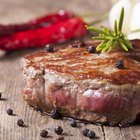
How to Make Beef Sirloin Tender

How to Cook a Prime Rib That Melts in ...

How to Make a Blackbuck Antelope Roast

How to Cook 5 Lbs. of Beef Tenderloin
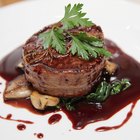
How to Cook Bacon-Wrapped Beef Chuck ...

What Is a Rib-Eye Steak?
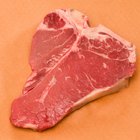
How to Broil Strip Steak
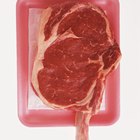
How to Cook a Steak on Grill Pan and ...

How to Broil Filet Mignon Wrapped in ...

How to Cook Bison Burger
How to Cook Sirloin Filets in a Pan and ...

How to Cook a Rib Eye to Medium-Well in ...

How to Make Salt Brine

The Best Ways to Cook Scallops
How to Cook Buffalo Fillet
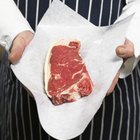
Tenderloin Filet Vs. Top Sirloin

How to Cook Marinated Pork Loin From a ...

The Best Way to Prepare Bison Sirloin

How to Cook Kobe Steaks
References
Resources
Tips
- Brush your filets with truffle oil before salting them to add flavor.
Writer Bio
Brynne Chandler raised three children alone while travelling, remodeling old homes, taking classes at the Unioversity of California Northridge and enjoying a successful career writing TV Animation. Her passions include cooking, tinkering, decorating and muscle cars. Brynne has been writing fun and informative non-fiction articles for almost a decade. She is hard at work on her first cookbook, which combines healthy eating with science-based natural remedies.
Photo Credits
Jupiterimages/Photos.com/Getty Images